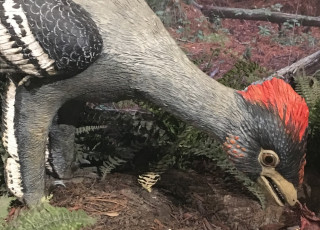Top Science Stories of 2024
By Jude Coleman
Scientists are making progress all the time, and 2024 was no exception. Many research fields had their moment in the spotlight, from major medical breakthroughs to surprising discoveries found in nature. As the year comes to a close, it's a chance to look back on what we’ve learned — and how far we’ve come.
Accuracy of Alzheimer's Blood Tests Grow
Diagnosing Alzheimer’s disease currently requires either a brain scan or a sample of spinal fluid. Researchers have been hard at work developing blood tests for the disease, which detect sticky proteins in the brain. Higher levels of these proteins can indicate that a patient has Alzheimer’s. While versions of the test have been around for several years, scientists are zeroing in on their accuracy. A few of the tests are even on the market, although they aren’t yet approved by the FDA.
Evolution of Vertebrates Becomes Clearer

The sole available specimen of Nuucichthys rhynchocephalus, one of the oldest known vertebrates in the world. The specimen originates from the Cambrian Marjum Formation in the House Range of Utah. Image courtesy of Rudy Lerosey-Aubril
Animals haven’t always had bones. But scientists are still figuring out exactly how or when the structures emerged. A 500-million-year-old fossil found in Utah is helping them understand how animals with bones — called vertebrates — eventually evolved. The fossil is of Nuucichthys, a small fish with some traits that resemble modern-day vertebrate features, like v-shaped muscle groups along its back. By examining this ancient fish, researchers can further fill in the evolutionary roadmap animals took to developing complex bodies.
A Galaxy Far, Far away
Astronomers spotted a Milky Way-like galaxy, christened REBELS-25. It’s the most distant galaxy of its kind that’s been found. And despite being younger than our own galaxy — the light scientists can see from it comes from just 700-million-years after the universe formed — REBELS-25 has pulled itself together surprisingly well. Young galaxies are generally thought to be messy and disorganized, but REBELS-25 already has a structure and rotation similar to the much olderMilky Way. The discovery could challenge scientists' understanding of how galaxies in the early universe took shape, but first, they need to learn more about it.
Europa Clipper Launched

NASA’s long-awaited Europa Clipper spacecraft took to the cosmos in October. It’s headed to Jupiter to study one of the planet’s moons (Europa, of course), an icy orb believed to have a liquid ocean beneath its frozen crust. Europa is astronomers’ best bet for a celestial body capable of hosting life — but it will take six years for the spacecraft to reach Jupiter’s orbit, and another year to start collecting data from the frozen moon. Clipper will conduct nearly 50 flybys of the moon, gathering data about things like the moon’s atmosphere and shell, and what lies beneath them.
A Map of Fruit Fly Neurons
Even the humble fruit fly has a complicated brain, containing more than 8,000 types of neurons, or nerve cells. Scientists spent years taking specialized microscopy images of a fruit fly’s brain, culminating in the most complete map of any organism’s brain ever made. The map features nearly 140,000 neurons and the 54.5 million ways that they’re all connected. While some of the fly’s brain circuitry was familiar, over half of the neurons researchers identified had not been seen before.
A Rare Cicada Emergence

Image via USGS Bee Inventory and Monitoring Lab / Public Domain
Periodical cicadas emerge every 13 or 17 years, depending on their brood. The insects spend most of their life underground, and emerge with a cacophony of buzzing in the summer to mate. In some Midwestern and Eastern states, two broods — XIX, a 13-year brood, and XIII, a 17-year brood — emerged together for the first time since 1724. Billions of the bugs took to the trees, in what some called a “cicada-geddon.” Descendants of these broods won’t be topside together again for another 200 years.
These Wolves Might be…Pollinators?

When they aren’t dining on rodents, Ethiopian wolves indulge in a sweet treat: the nectar of red hot poker flowers. The wolves lick these Dr. Seuss-esque flowers like a giant, floral lollipop, and end up with pollen-covered snouts. Because they move from flower to flower, the endangered canines might transfer that pollen between blooms — making them an unexpected pollinator. If that’s the case, they represent the first large carnivore to join ranks with bees and butterflies.
New Species of Horned Dinosaur Discovered

Lokiceratops rangiformis Illustration by Andrey Atuchin
When you think of a horned dinosaur, odds are you might imagine a Triceratops. But millions of years before Triceratops was around, there was Lokiceratops: a never-before-seen cousin of the iconic herbivore. Archaeologists found Lokiceratops’ fossilized remains in northern Montana, and reconstructed its skeleton at the Museum of Evolution in Denmark. Its array of horns and paddle-like head ornaments tipped off researchers that they had discovered a new species. Both Lokiceratops and Triceratops are in a larger group of dinos called ceratopsians, but are part of separate subgroups within that.
Marmosets Use Names

Only a handful of animals are known to have names for each other. Humans, of course, as well as elephants and dolphins — and now, marmosets. Particularly when separated, the pint-sized monkeys use unique calls to address each other, and can recognize when someone is calling them. Even adult marmosets who were unrelated used these labels for each other, suggesting that their names can be learned. The monkeys are the first non-human primates found that use individual labels for their peers.




